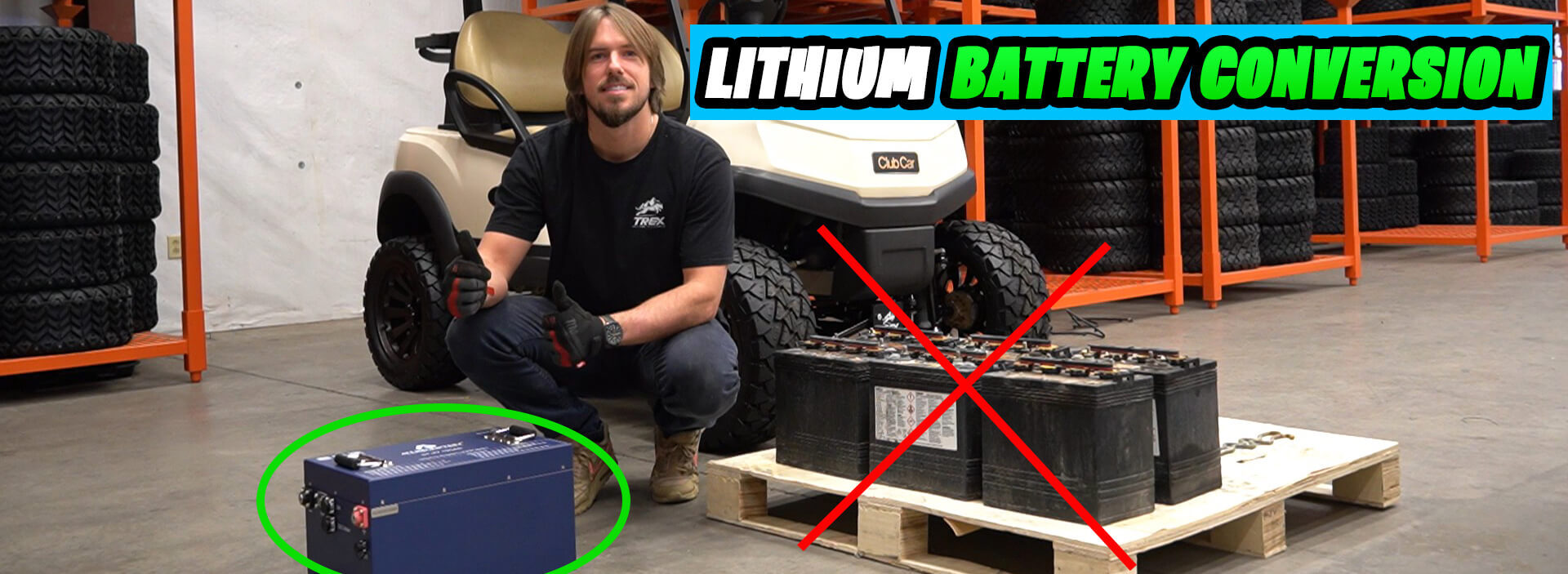
First: A Quick Note on Why Lithium Golf Cart Conversion is so Popular
Back in late 2019, we were the first golf cart website online to tell you that Lithium Golf Cart Batteries were the future. Back then, only a few lithium battery brands existed. Today there are over 30 brands, and all major golf cart manufacturers (Club Car, Yamaha, EZGO, etc.) offer lithium directly from the factory.
Yes, it’s THAT good.
But what if your cart didn’t come with lithium batteries? If your cart is older than 2019, or if you didn’t opt for the lithium upgrade when buying your newer ride, chances are you’ve thought about making the switch.
The good news? You can easily convert any golf cart to Lithium power with bolt-in or drop-in solutions that you can install in an afternoon, and you can enjoy all the major benefits of lithium golf cart batteries, including:
- Fully charge in 2–3 hours (vs. 8–10 hrs for traditional Lead-Acid batteries)⚡
- They live longer (3x–5x longer) than traditional golf cart batteries
- They are lightweight! (reduce battery weight of your cart by 300 lbs = more efficient cart)
- Require ZERO maintenance (no adding water, cleaning corrosion, or checking acid levels)
- Lithium-Ion batteries do not lose power as charge dips (they don’t get ‘tired’ as they are used)
How to Convert Golf Cart to Lithium
Before you can begin your conversion, you first need to make sure you purchase the right lithium golf cart battery for your cart. Make sure that the Voltage of the new battery is the same as the voltage of your old batteries / your cart’s power system:
- 36V carts need a 36V lithium battery setup
- 48V carts need a 48V lithium battery setup
- 72V carts need a 72V lithium battery setup
Once you've got the right lithium battery kit, follow the steps below. Video is included as well to make things super easy!
Step 1: Safety First & Prep Work
- Put the golf cart in Tow mode.
- Turn the ignition key Off.
- Put the parking brake On.
- Remove the seat to access the battery compartment.
Step 2: Remove Old Lead-Acid Batteries
First we need to get your old batteries out of your cart. Golf cart batteries are heavy, so be careful with this step so you don't injure yourself. Recruit a friend or family member for a second set of hangs on this step!
- Disconnect the main positive and main negative cables (connected to the cart’s controller/ground).
- Disconnect all remaining battery cables between the batteries using a 1/2" socket.
- If installed, remove any watering system hoses (leave the battery watering caps in place though).
- Remove any battery hold-down brackets. You will need a socket set for this. If you have J-Hooks, keep them on the side. Your battery kit may reuse them.
- Carefully lift out the old lead-acid batteries (use a battery strap—these are heavy).
- Pro Tip: If you don't have a battery strap, a strong leather or nylon belt works great!
Step 3: Disconnect Old Charging Receptacle wires from your Controller and Solenoid
With your new lithium golf cart battery setup, the factory charge port on your cart won't be needed any longer. It will either be replaced with a new 110V port, or not used at all depending on your kit. Most lithium batteries come with a built-in 110V charging plug (just like a standard household plug). You can you can simply run this out from under your seat and plug into your wall when you need to charge.
- In the battery compartment under your golf cart’s seat, you will find the backside of your cart’s charging receptacle.
- Trace back the wires from the charge receptacle, to your cart's controller and solenoid and disconnect them.
- Your cart will no longer use its original charger port. Instead, it will use a standard 110v plug now. So we no longer need these wires or the factory charge port in the cart.
- With these wires disconnected, you can remove the old charge receptacle from the cart body as well.
Step 4: Install New Charge Port (Optional)
If your kit included a new 110V charging port, then you’ll want to replace the original factory charge port we just took out, with the new 110V one. We will install this new 110V port right where your factory charge port used to be. But the nice part is we will just be hooking this up to your new battery, so no need to go back into the wiring on your controller and solenoid from Step 3 after we get it into place.
- Install the new charging receptacle in the factory location (if included in your kit).
- Using the original factory screws, secure the new 110V charge port in place.
Step 5: Mount the New Lithium Golf Cart Battery
Now the fun begins! It's time to get your new lithium battery into the cart. Your battery will be installed one of three ways: using mounting brackets, direct to tray, or factory hooks. If you purchased Parallel series lithium batteries (true "drop-in" style), then you will just simply place your batteries into the compartment where your old batteries used to be. But for this install, we are focused on Large Lithium Battery Packs.
- Using Mounting Brackets:
- Install the battery mounting brackets in the bottom of the battery tray. First, measure to make sure your four holes will square-up with the feet tabs on your battery.
- Once lined up, drill pilot holes for where you will mount the battery brackets.
- Next, drill larger bolt holes in the same spot for your kit size (typically 5/16" holes).
- Using supplied bolts, washers, and nuts, secure battery the brackets to the battery tray.
- Place the lithium battery onto the new brackets and secure it
- Direct to Battery Tray (for flat trays with enough space):
- If your battery tray is flat and smooth (and does not require you to use a bracket), you can use self tapping screws to mount your battery directly to the plastic battery tray.
- Once lined up, secure battery to the battery tray using properly size self tapping screws and a power drill. These screws should fit through the mounting tabs, but the head of the screw should secure the edges of the tab to mounting surface.
- Using Factory Hooks:
- If your battery came with a thru-hole setup (such as ECO battery), then you will reuse your battery hold down hooks.
- Place the battery into the bay near one of your original mounting hooks.
- Line up the battery hook with the hole running through the center of your battery.
- Secure the hook using factory hardware.
Step 6: Install the On Board Charger
All lithium battery bundles include an on-board-charger (OBC). This simply means, the charger gets mounted "on board" inside the golf cart, so it goes everywhere the golf cart goes. This is a huge benefit, because you can charge the cart anywhere you go, as long as you have a 110V house outlet available.
- Mount the onboard lithium charger in your carts battery bay using self-tapping screws. For the ALLIED kit pictured in this article, these are #10 self tappers we use to mount the charger.
- Screw the self-tappers directly into battery tray plastic, through the openings in the tabs on the bottom of the charger.
- Connect the on-board-charger’s power output circular plug to the battery’s circular input port for the charger (this is how the electric juice gets to your battery from the charger).
- Plug the charger’s power input (male 110V house plug) into the female 110V plug of your new charging receptacle cable (this is how your charger gets power from the wall).
- If you aren't using a new 110V charging receptacle from Step 4, then you will just leave the male 110V plug from the on-board-charger unplugged/loose in the battery bay.
Step 7: Install State of Charge Meter (Optional)
Most new lithium battery conversion bundles include a State of Charge meter (SOC) to install on your golf cart. This meter acts as a fuel gauge for your new lithium battery, indicating how much charge is left at any given time as you drive around. You have the option to flush mount this gauge into your dash (cleaner, but requires drilling), or to use a bracket and mount on your steering column. If your kit did not include a SOC meter, skip this step. Most good lithium golf cart batteries at minimum have a Bluetooth app to monitor charge levels.
- While sitting in your driver's seat, find an easily visible place to install the SOC meter. Most of our customers choose somewhere flat on the dash.
- Remove the dash from your cart, and ensure there is enough room in the space BEHIND where your SOC meter will sit once installed.
- With spacing confirmed, go ahead and grab your power drill with the proper size attachment (usually 2"). We recommend the Milwaukee Holedozer.
- Drill a 2" hole in your dash in the desired SOC meter location.
- Plug in your multi-pin SOC meter cable into the SOC meter port on your battery.
- Run the cable under your kick plate (body panel that supports your seat and separates your battery area from your floor mat area) and along the floor board of your cart up behind the dash.
- Plug the SOC meter cable into the back of your SOC meter, and mount the meter into the hole you drilled using your kits' included bracket and nuts.
Step 8: Connect the Battery & Final Touches
- Connect the main negative cable and charger negative cable to the battery’s negative terminal.
- Connect the main positive cable and charger positive cable to the battery’s positive terminal.
- Tighten all connections securely.
- Install protective terminal covers, if your kit included them.
- Secure all cables with zip ties or P-clips (optional, but nice and clean).
- Reinstall dash panels, kick plates, and floor mats. Be sure to secure everything as it was pre-install.
Step 9: Power Up, Check & Charge
- Switch the cart from Tow mode to Run mode.
- Press and hold the lithium battery power button until the light turns on.
- Confirm the SOC meter lights up.
- Note: Your meter will likely read under 50% the first time you test your battery. This is normal.
- IMPORTANT: Fully charge the new lithium battery before your first drive.
If everything is working perfectly, then it's time to reinstall your cart's front seat and charge the cart. You're all done! Welcome to the LITHIUM POWER ARMY.
All Done!
Converting your golf cart to lithium is one of the best upgrades and strongest investments you can make for your golf cart. A lithium golf cart conversion isn’t just about more power—it’s about reliability, performance, and zero maintenance. There is a reason all the major manufacturers are going this route. And while lithium golf cart batteries were very expensive 5-years ago, they have come down in price to be almost a no brainer for your golf cart.
If you have ANY questions at all before you purchase a lithium battery for your golf cart, please give us a call! The GCTS Golf Cart Experts are always here to help. Our team is extremely well versed in golf cart batteries, because they are almost as important as your tires for your cart ;).
Last Updated: 3/31/2025






